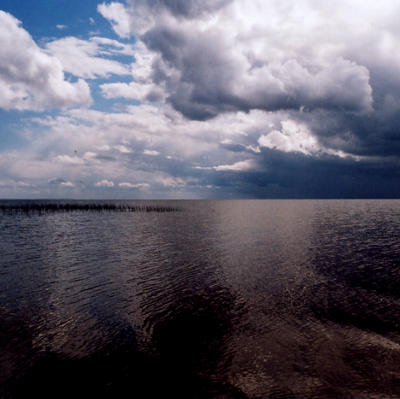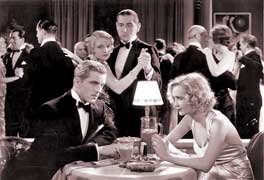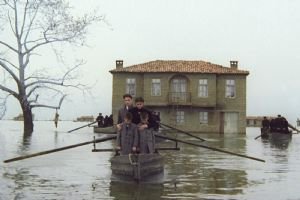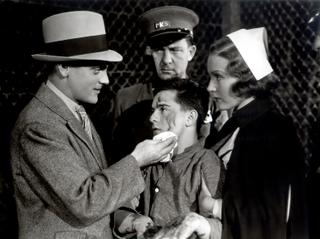NOTE: THIS ENTRY HAS BEEN SALVAGED FROM THIS SITE AND REPOSTED UNEDITED ON 9/7/2009. SOME INFORMATION MAY BE OUTDATED, AND OUTGOING LINKS HAVE NOT BEEN INSPECTED FOR REPUBLICATION. COMMENTS CAN BE FOUND HERE.
* * * * *
Three weeks ago I went to the
Pacific Film Archive to view my first James Benning film,
13 Lakes. Though I'd heard of Benning and some of his films (particularly his
California Trilogy) before, I only had a vague idea of what they might be like until two directors (Amir Muhammed and Jenni Olson) mentioned him as an influence on their films (
Tokyo Magic Hour and
The Joy of Life, respectively) at the San Francisco International Film Festival earlier this year. I was intrigued, as the most Benning-inspired segment was my favorite part of Amir's film, and Olson's film was my favorite of the entire festival.
And so I found myself sitting before the PFA's screen, watching thirteen carefully-composed, ten-minute-long shots of American lakes. And so I experienced a different way of watching a film than I ever had before. Changes in the images were usually slow and subtle, with very little of what is normally evoked by the term "screen movement". The first was
Jackson Lake in Wyoming, and it was a study of the changing light and color at dawn, with Mount Moran and its reflection in the water as the canvas. After ten minutes and a fade to black, each shot gave way to a new lake with a new soundtrack, a new reflection of light on its surface, a new cloud cover, a new rhythm of rippling in the water. Though I've spent quite a bit of time in the outdoors, and even spent summers trying to teach teenagers about observing nature, I'm not sure I've ever really looked at something for even ten uninterrupted minutes before. Benning's film is a solicitation for viewers to look at his film as they might at a painting, or would if the oil in a painting could shimmer, swell, float, foam, flutter, or wave. It also asks us to look more closely at the natural world.
I won't pretend that I caught on right away. I nodded off for a bit in the middle of the second shot at
Moosehead Lake, so its composition didn't burn into my brain like the other twelve did. I grew quite restless during the
Salton Sea segment, even though I found it humorous to hear the constant soundtrack of jetskiers' engines, and then to see the vehicles unwittingly play peekaboo with Benning's camera. It wasn't until the calming
Lake Superior shot that I started to realize the usefulness of taking the whole image in at once rather than darting my eyes around the screen looking for what little movement there was to be had. Still, this method worked better for some shots than for others. In fact, each lake seemed to suggest a slightly different way of looking and listening. At the speed at which wind blew snow onto the surface of
Lake Iliamna it seemed almost unlikely that Benning and his camera weren't blown forward into the icy Alaskan water too. By contrast, the water in
Crater Lake was tranquil enough to cast a perfect reflection of the rim of the dormant volcano in which it lies, which naturally encouraged attention to focus on changes in the soundtrack. The final shot left me exhilarated; the rippling waves of
Oneida Lake moved toward the camera at just the right angle and speed to create the illusion of a weightless tracking shot. If I made sure to keep my eyes focused on the edges of the frame it seemed as if I were floating out over the lake, though never getting any closer to the opposite bank.
The next day I read
this Senses of Cinema article on
13 Lakes. Its author, Michael J. Anderson, insightfully knits connections between Benning's film and the concept of the frame André Bazin explored when writing on Jean Renoir's
The Rules of the Game. The essay culminates in a discussion of the Lake Iliamna shot, leading to a fascinating conception of the cinema screen as an imagined portal to the world on the other side of Benning's camera. And then for the bizarre postscript: Anderson tries to define
13 Lakes as a "defiantly non-environmentalist" film, morphing an intelligent piece of film criticism into a conservative rant against what he sees as an "environmental orthodoxy."

I'm all for film and art that can bear a wide diversity of interpretations. I do not require films to express particular political points of view I ascribe to; in fact I find the majority of films that do so to be rather tiresome because of it. And some of my favorite films can be found on
this list, most notably
Fort Apache,
Ruggles of Red Gap and
I Know Where I'm Going! (though I think Ian Christie's Criterion DVD commentary makes a strong case for the latter film as exemplary of Britons' swing toward Labour at the end of World War II). Still, I absolutely consider myself an environmentalist, and do not want to let Mr. Anderson's conclusions stand unchallenged. Especially not at this moment in time, when one of the lakes captured in Benning's film,
Lake Ponchartrain, has become so absolutely relevant.
I am open to a true interpretation of
13 Lakes as a non-environmentalist film. However, the evidence Anderson supplies in his argument does not come from the film itself, but from his evaluation of comments Benning made in response to audience members' questions after a screening:
...in one of the most telling moments of the post-film wrap-up, one viewer began her question by stating that she knows that the filmmaker is an environmentalist. To this, Benning quickly rejoined, glibly, that he is in fact not an environmentalist, as should be evident by the ten thousand miles he drove in the making of the film. While he later conceded that one of the points of the film is the condition of the lakes at the moment of filming, he held that he is an outsider to the movement. The point being made by Benning was not that he is unconcerned with nature, but rather that he does not agree with all of environmentalism's tenets.
More to the point, Benning does not share certain presuppositions of the environmentalist movement. Tellingly, Benning in a further elaboration of his divergence from this school of thought averred that the lakes themselves would be around long after the rest of us have gone. The implication of this observation, certainly, distinguishes the director from environmentalist orthodoxy: to Benning, the environment is resilient, whereas it is its frailty that instructs environmentalist orthodoxy.
Anderson wants readers to accept a straw man construction of an emotionally-based environmental movement ignorant of scientific fact. Such a construction can be seductive because everyone has encountered environmentalists who seem wholly unconcerned with facts, or those with a naive conception of the natural world they're trying to protect.
But Anderson tries to tar the whole of environmentalism with the same brush, especially when he quotes a Michael Crichton
speech calling for an environmental movement "based in objective and verifiable science" without offering substantial evidence that it isn't already. Most environmentalists' conviction comes not out of an emotional or "religious" wellspring, but as a rational response to scientific facts. Facts that indicate a conflict between the current patterns of production and consumption in industrial and post-industrial societies and the health and overall quality of life for human beings, whether on a local or global scale.
Taking a closer look at Anderson's piece, there are indications in the body of his analysis that foreshadow his conclusions in the postscript, making it seem a little less like a non-sequitur. His very first paragraph minimizes "human incursion" in the film, ignoring the fact that several of the filmed lakes have been greatly shaped by human intervention. For example, the Salton Sea took its current form early in the last century with the flooding of a man-made canal, and would dry up if not for the irrigation of the Coachella and Imperial valleys.
Lake Powell was just a stretch of the Colorado River until the completion of Glen Canyon Dam in 1963. And the visible clumps of algae floating on the edge of
Lake Okeechobee are surely caused by agricultural nutrient runoff. Later Anderson states that the movement in
13 Lakes is created by changes "inherent in nature". The film provides a preponderance of evidence against this notion, most clearly in the Lake Pontchartrain shot in which on-screen movement is provided by an endless stream of automobiles driving across the Causeway that connects New Orleans to the bedroom communities on the lake's North Shore. This image evoked the relationship between the oil industry and the ecological condition of the lake when I saw it three weeks ago; post-Katrina it becomes all the more charged with significance.

A week after the
13 Lakes screening, I went back to the PFA to watch its companion piece
Ten Skies and to hear Benning talk about his work in person. Perhaps because
13 Lakes had warmed me up for it, I found
Ten Skies to be an even more beautiful and revelatory work. Because its ten shots were not literally grounded by a horizon line as in
13 Lakes, watching them was an experience even more alien to someone weaned on "traditional" forms of cinema. The painterly qualities of the light, color and form were all the more apparent, as were the constant changes in all three. And because the essence of the film was nothing else but the ephemeral vapor of clouds and smoke, completely isolated in the frame from any recognizable topography, watching the film seemed even more than for
13 Lakes an exercise in the act of seeing images outside the context of any text. A subject without matter, if you will.
Yet once again I could not view the film as completely divorced from environmentalist concerns. The second shot in
Ten Skies is of smoke rising out of a fire. As I watched the battle between the dark smoke and the remaining patches of light blue for control of the frame, questions emerged. Was this a forest fire or a grass fire? How was it started? Was it a controlled burn or a wildfire? Does the helicopter on the soundtrack help answer these questions? The seventh shot showed white steam billowing out of what must have been some kind of industrial plant, and similar questions were raised. And the ninth shot contained little, dark streaks that I assumed were patches of smog or some other breed of pollution. Surely the filmmaker did not include such shots in his film and expect the viewer to ignore the consequences of human impact on the natural environment?
A question-and-answer session following the film provided me with an opportunity to solicit an opinion on this matter from Benning himself. Midway through the session, nervously gripping the microphone in my hand, I explained that I'd seen
13 Lakes the previous week and subsequently read an article claiming that he wasn't an environmentalist. I asked him to clarify whether he was an environmentalist, an anti-environmentalist, or neither, and to comment about how his films reflect his views on environmentalism. He began his answer by repeating the line reported by Anderson, that his thousands of miles of driving to these lakes surely conflicted with environmentalism. But he went on to clarify further that in fact he was quite concerned with the state of the environment; that he was an environmentalist after all, but simply not a practicing one. Which, he admitted, made him in fact a hypocrite, something he was not proud of.
I am not suggesting that this exchange, recorded with uncertain accuracy in my notebook and reproduced in the above paragraph, represents the last word on these two films and their relationship with environmentalism. I do hope those of you intrigued enough to have read this far will seek out Benning's films and see how your own reaction compares. (I know they've been programmed for the upcoming
Vancouver International Film Festival, but am not aware of more Bay Area screenings scheduled) And if you disagree with my take on these films, or any others I've written about on this blog or in
my occasional pieces elsewhere, let me know, either by
e-mail or in the comments below.
 The highlight of the evening for me was finally seeing Conner's longest (at 37 minutes) and most leisurely paced film, Crossroads. Constructed out of footage taken from 27 different cameras watching the nuclear explosion at Bikini Atoll in July 1946, Conner's film forced me to contend with the beauty of its iconic mushroom cloud imagery and the concept of cinema as a record of destruction and decay. The division of the film into two halves, marked by the change of composer (Patrick Gleeson to Terry Riley) lends a taste of narrative structure that most of us expect from documentaries.
The highlight of the evening for me was finally seeing Conner's longest (at 37 minutes) and most leisurely paced film, Crossroads. Constructed out of footage taken from 27 different cameras watching the nuclear explosion at Bikini Atoll in July 1946, Conner's film forced me to contend with the beauty of its iconic mushroom cloud imagery and the concept of cinema as a record of destruction and decay. The division of the film into two halves, marked by the change of composer (Patrick Gleeson to Terry Riley) lends a taste of narrative structure that most of us expect from documentaries. 
















